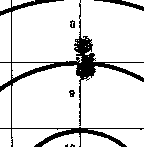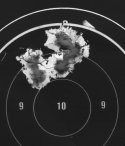The Steyr Scout Database
![]()
This page is devoted to the performance of the Steyr Scout rifle as determined from my own testing and testing or field experience reported to me by others. Data will be added as it is received. All performance data supplied to me by others is believed to be accurate but that fact is not guaranteed. Please note that your own results may vary.
If you have data you wish to share you can email it by clicking here. . For accuracy data please supply distance fired at, number of shots per group, and number of groups fired. For handloads please supply bullet type and weight, powder type and charge weight, case brand, primer brand and type, and overall length and the average weight of 3 cases without primers. If available please supply velocity data.
On this page
Accuracy Tests | Velocity Tests | Loading Data | Zeroing Information |
| Ammunition/Load | Range | # Rds per group | # Grps Fired | Max/Min/Avg Group | Comments |
| Hornady 150 gr Light Magnum (#8590) | 100 | 3 | 4 | 1.1/.47/.82 | Hornady factory test results |
| Hornady 150 gr Light Magnum (#8590) | 200 | 3 | 1 | 3.2 | |
| Federal 168 gr Match | 100 | 3 | 10 | 1.6/.37/.87 | composite data from many sources |
| Federal 168 gr Match | 200 | 5 | 8 | 2.5/1.4/1.9 | composite data from many sources |
| Federal 168 gr Match | 200 | 18 | 1 | 2.68 | 18 rds shot on one target |
| Federal 168 gr Match | 300m | 5 | 1 | 2.0 | |
| Samson/IMI 168 gr Match | 100 | 3 | 1 | .68 | |
| Fed Premium 165 gr Trophy Bonded | 100 | 3 | 1 | .87 | |
| Fed Premium 165 gr TB High Energy | 100 | 3 | 1 | 3.0 | |
| Fed Premium 165 gr TB High Energy | 200 | 3 | 1 | 1.5 | Note difference in group size fromm 100 yds (stability problems?) |
| Fed Premium 180 gr Trophy Bonded | 100 | 3 | 1 | 1.0 | |
| Fed Premium 180 gr TB High Energy | 100 | 3 | 1 | 2.0 | |
| Rem 150 gr CoreLokt SP | 100 | 3 | 1 | 1.0 | |
| Win 150 gr SilverTip SP | 100 | 3 | 1 | 2.4 | |
| Rem/UMC 150 gr "Ball" | 100 | 3 | 1 | 1.25 | |
| Win 147gr "Ball" | 100 | 3 | 1 | 1.2 | |
| Hand load Horn 165 gr Match | 100 | 3 | 1 | 1.0 | 45gr 748/Fed primers V=2600 |
| Hand load Nosler 165 gr BT | 100 | 3 | 1 | .94 | 45gr 748/Fed primers V=2600 |
| Fed 150 gr "Ball" | 100 | 3 | 2 | 1.44/.95/1.2 | |
| "Mex Match" 168 gr Sierra | 100 | 3 | 3 | 1.6/1.2/1.3 | LC M118 lot 60-20 w/ Sierra |
| Norma Jaktmatch 150 gr | 100 | 3 | 3 | 1.0 | |
| Winchester Failsafe 180 gr | 100 | 3 | 3 | .85 | |
| Winchester Failsafe 180 gr | 200 | 5 | 1 | 2.0 | 4 rds into .88 |
| Remington 150 gr SP | 100 | 5 | >2 | sub moa | under 1" consistently |
| Georgia Arms 168 gr Match G308M | 100 | 3 | 1 | .27 | Best group recorded from Steyr Scout |
| Georgia Arms 168 gr Match G308M | 100 | 5 | 2 | <=.5" | Another outstanding performance |
| Sako Range 123 gr Match | 100M | 5 | 1 | 18 mm | That's a .71" group at 100 M |
Below is a picture of what I believe to be the best group fired from the Steyr Scout so far. It was fired on 1998-12-26 by Sue Hildebrandt using the bipod and the prone position. She reports that the rifle was simply removed from the box, the bore wiped with a dry patch, and then fired using the factory sight settings. The group measures .27" for 3 shots and was 2" above the aim point--very close to the perfect zero for a .308. The ammunition was Georgia Arms 168 gr Match.

Here is another super 5-shot group. It was fired by Niko Visuri of Finland at 100 m with Steyr Scout .308 Jeff Cooper package and measured (18 mm). Ammunition was Sako "Range" .308 Win Ammo, #120A (123 grs full jacket bullet with a listed muzzle velocity of 900 m/s (2950 f/s).

| Ammunition/Load | Temp | # Rds per group | # Grps Fired | Avg Vel | Comments |
| Hornady 150 gr Light Magnum (#8590) | unk | 3 | 4 | 2835 | Hornady factory test data |
| Federal 168 gr Match | 78 | 5 | 3 | 2600 | |
| Hornady 165 gr Light Magnum (#8595) | 78 | 5 | 1 | 2755 | |
| Norma Jaktmatch 150 gr | unk | unk | unk | 2589 | |
| Federal High Energy 180 gr | unk | unk | unk | 2651 |
You may notice that some of these figures seem high for a 19" barrel, but they are the actual data. The hammer forged Steyr barrels are very smooth and higher than normal velocities seem to be the norm. Also see loading data below.
DISCLAIMER
All loading data presented here was safe in the firearm tested and under the conditions tested. Since neither Steyr Mannlicher, SteyrUSA, nor Fr. Frog has any control over the manufacture of the various components listed, the actual loading, nor the components you actually use, no responsibility for the use of this data is implied or assumed. Safe reloading practice dictates that you reduce all stated loads by 10 percent and carefully work upwards. Note that Norma cases have substantially greater case volume than most US cases and stated velocities may not be achievable.
| Bullet | Case | Primer | Powder | Charge | OAL | Velocity | Accuracy |
| 165 gr Hornady Match | RP | Fed | 748 | 45 | unk | 2600 | MOA |
| 168 gr Sierra MK | n/a | Fed BR | 748 | 43.5 | unk | unk | sub MOA |
| 168 gr Sierra MK | n/a | n/a | IMR 4895 | 40.0 | sub MOA | ||
| 150 gr Lapua LB | Lapua | Fed 210 | N-540 | 49.1 | 2830 | ¾ MOA | |
| 168 gr Sierra MK | Lapua | Fed 210 | N-140 | 43.0 | 2465 | Not stated | |
| 167 gr Lapua Scenar | Norma* | Fed 210 | N-550 | 49 | 2660 | ¾ MOA | |
| Norma Oryx 180 gr | Norma* | Fed 210 | N-550 | 50 | 2630 | ¾ MOA | |
| Nosler 165 gr Bal Tip | Rem | Fed GM210M | BL-C(2) | 46.5 | 2.832 | unk | sub MOA (5 shot) |
| 165 gr Hornady SPBT | Fed Match | Fed 210M | Varget | 45.5 | 2.80 | 2700 | sub MOA |
| 165 gr Hornady SPBT | Fed Match | Fed 210M | N-140 | 45.0 | 2.80 | 2700 | sub MOA |
| 165 gr Hornady SPBT | Fed Match | Fed 210M | N-140 | 45.5 | 2.80 | 2750 | MOA |
| 125 gr Nosler Bal Tip | Fed Match | Fed 210M | N-140 | 48.5 | 2990 | sub MOA | |
| 180 gr Hornady SPBT | Fed Match | Fed 210M | N-550 | 46.0 | 2611 | sub MOA | |
| 168 gr Hornady A-Max | Fed Match | Fed 210M | N-140 | 42.5 | 2.80 | na | sub MOA |
* Note: Norma cases are very light and hold about 1.4 gr more than Federal or Lapua
Zeroing Information for the Scout
Ideally the best zeroing range to use is the one that gives you the longest "point blank" range. However, that figure is dependent upon what you consider to be an acceptable "critical zone" (the diameter of your lethal zone on your target). Most people use a zone of 6" which means ± 3" on the line of sight.
For .308 Winchester ammunition using 150 to 165gr bullets a good zero range is about 225 yards (216 meters) which puts the point of impact at 100 yards at about 2.8 inches above the point of aim (a hair under 3 inches (7.6cm) at 100 meters). This will keep the actual point of impact within ± 3" out to about 265 yards (242 meters) and put you about 7" (18cm) low at 300 yards (274 meters) and about 2 feet low (61cm) at 400 yards (365 meters). You can use one of the many ballistics programs available to compute trajectories for your ammunition.
You should refine your data by test firing but you'll probably be close to these figures. The sight height for the Steyr Scout is 1.4 inches. Addition information on zeroing the Steyr Scout and a handy zeroing target (in MS Word format) designed for the heavy factory reticle can be accessed by clicking here.
If you are interested in learning more about the subject of ballistics or zeroing you can click here to go to Fr. Frog's home page and visit the Ballistics pages.
| General Info and Specifications | Personal Observations | Scout Scope Specifications |
| Scout Articles In The Gun Press | The Scout "Team" |
| Steyr Scout Tips & Tricks | The Big Bore Scout & .376 Cartridge | The Tactical Scout Rifle |
| The Steyr Mannlicher Company History |
| Back to Fr. Frog's Home Page |
Email me by clicking here.
Neither Fr. Frog, the hosting service for these pages, nor this page is officially associated with Steyr Mannlicher or SteyrUSA. This page provided by Fr. Frog as a service to the friends of Jeff Cooper, the folks Steyr, and the shooting community. Fr. Frog is not responsible for any errors, omissions, nor your inability to hit what you aim at when using this rifle. As far as I know all the information presented is correct and I have attempted to ensure that it is. However, I am not responsible for any errors, omissions, or damages resulting from the use or misuse of this information, nor for you doing something stupid with it. (Don't you hate these disclaimers? So do I, but there are people out there who refuse to be responsible for their own actions and who will sue anybody to make a buck.)
And, as stated in the loading data section, all loading data presented here was safe in the firearm tested and under the conditions tested. Since neither Steyr Mannlicher, SteyrUSA, nor Fr. Frog has any control over the manufacture of the various components listed, the actual loading, nor the components you actually use, no responsibility for the use of this data is implied or assumed. Safe reloading practice dictates that you reduce all stated loads by 10 percent and carefully work upwards. Note that Norma cases have substantially greater case volume than most US cases and stated velocities may not be achievable.
Updated 2011-12-13